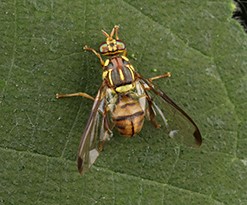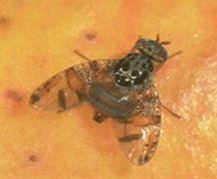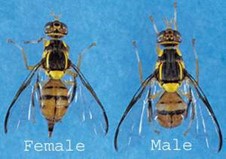
Invasive Fruit Fly Quarantines in California
California is experiencing an unusually high number of invasive fruit fly detections this season. The California Department of Food and Agricultural (CDFA), in cooperation with the United States Department of Agriculture (USDA) and County Agricultural Commissioners, has initiated local regulatory measures to eradicate and prevent the statewide spread of Queensland Fruit Fly, Tau Fly, Mediterranean Fruit Fly, and Oriental Fruit Fly.
Counties Currently Impacted by Invasive Fruit Fly Quarantines:
- Oriental fruit fly: Contra Costa, Riverside, Sacramento, San Bernardino and Santa Clara Counties
- Mediterranean fruit fly: Los Angeles County
- Tau fruit fly: Los Angeles County
- Queensland fruit fly: Los Angeles and Ventura Counties
We Need Your Help!
- Now is a critical time for residents in fruit fly quarantine areas to protect their backyard fruits and vegetables from invasive fruit flies.
- To prevent the spread of invasive fruit flies through homegrown fruits and vegetable, residents living in the invasive fruit fly quarantine areas are urged not to move any fruits and vegetables from their properties.
- Fruits and vegetables may be consumed or processed (i.e. juiced, frozen, cooked, or ground in the garbage disposal) at the property where they were picked.
- If they are not consumed or processed, please dispose of them by double-bagging in plastic bags and putting the bags in the garbage bin for collection, not green waste.
-
If you are in an established quarantine area:
- Please do not compost fruit or vegetables. Double bag and dispose of them in the regular waste bin, not the green waste bins.
- Don’t let ripened homegrown produce fall to the ground. Remove mature produce that has fallen to the ground by double bagging and disposing in the regular waste bin, not the green waste bins.
- Before entering the United States from another country, declare agricultural products — including fruits or vegetables — to U.S. Customs and Border Protection – Help us protect our agriculture, natural resources, and unique biodiversity from invasive fruit files – Please Don't Pack a Pest when traveling or mailing/receiving packages.
- Buy fruit trees and vegetable plants from licensed California nurseries, as receiving agricultural goods from uncertified sources can spread invasive pests. Source your plants locally and responsibly. To search for a licensed nursery near you, visit CDFA’s Directory of Licensed Nurseries.
- Inspect your garden for signs of invasive fruit flies or maggots and report any findings to CDFA at 1-800-491-1899 or your local county agricultural commissioner’s office.
- Please cooperate with agriculture officials and allow them access to your garden to inspect plants.
A Message About the Oriental Fruit Fly (3:38) | En español
Pest Profiles
Queensland Fruit Fly
-
Impacted Crops
- See Crop List
- Quarantine Map
-
Description
- The adult female QFF is approximately 6 mm in length, it has a wing expanse of 10 to 12 mm, and it has transparent wings. Body coloration is brown marked with yellow. The dorsum of the thorax has a broad creamy band with a narrow yellow stripe on either side. The abdomen is constricted at the base, and broadly rounded at the tip.
- Pest Profile
- Quarantine Boundaries

Tau Fly
-
Impacted Crops
- Tau fly has a broad host range ; at least 34 hosts in nine plant families are reported, including melon, okra, peppers, papayas, citrus, cucumber, pumpkin, avocado, tomato, and gourds. It is considered a significant pest of cucurbits.
- Quarantine Map
-
Description
- The adult tau fly is approximately 7 mm in length (similar to that of a housefly). The body is yellow with black markings. The clear wings have two dark stripes, one along the front margin that ends in a dark spot and one about half as long running diagonal from the wing base. The female has a pointed slender ovipositor to deposit eggs under the skin of host fruit. The egg is almost one millimeter in length, white, cylindrical, and about four times as long as wide. The larva is creamy-white, legless, and may attain a length of nine millimeters. The pupa is encased in a dark brown cylindrical puparium.
- Pest Profile
- Quarantine Boundaries

Mediterranean Fly
-
Impacted Crops
- apple, apricot, avocado, bell pepper, carambola, coffee, dates, fig, grape, grapefruit, guava, lemon, lime, loquat, lychee, mango, nectarine, orange, papaya, peach, pear, persimmon, plum, pomegranate, pummelo, quince, sapote, tangerine, tomato, and walnut.
- Quarantine Map
-
Description
- The Mediterranean fruit fly is a short, squat fly about 1/4 inch in length (Fig. 1). It has a blackish thorax marked with silver; a tan abdomen with darker stripes extending across the abdomen; and clear wings with two light brown bands across the wing, another along the distal front edge, and gray flecks scattered near the base. The immature stages are superficially similar to those of other invasive fruit flies (Fig. 2). Eggs are white, very small, elongate, and somewhat banana-shaped. Larvae are white, legless, and somewhat carrot-shaped. The pupa is contained inside an elongate oval, shiny brown, hard puparium.
- Pest Profile
- Quarantine Boundaries

Oriental Fruit Fly
-
Impacted Crops
- The oriental fruit fly has been recorded from 478 kinds of fruit and vegetables (USDA 2016), including: apricot, avocado, banana, citrus, coffee, fig, guava, loquat, mango, roseapple, papaya, passion fruit, peach, pear, persimmon, pineapple, surinam cherry and tomato. However, avocado, mango and papaya are the most commonly attacked. PDF with species list
- Quarantine Map
-
Description
- The adult oriental fruit fly is somewhat larger than a housefly, about 8 mm in length. The body color is variable but generally bright yellow with a dark “T” shaped marking on the abdomen. The wings are clear. The female has a pointed slender ovipositor to deposit eggs under the skin of host fruit. Eggs are minute cylinders laid in batches. The maggots (larvae) are creamy-white, legless, and may attain a length of 10 mm inside host fruit.
- Pest Profile
- Quarantine Boundaries
- Fruit Removal Area Map (San Bernardino County)
- Oriental Fruit Fly Quarantines in San Bernardino and Riverside Counties: What to Expect — English | en Español


